Eating healthy and French food vocabulary
Updated: 13 March, 2021 by Mylene in French Vocabulary ▪
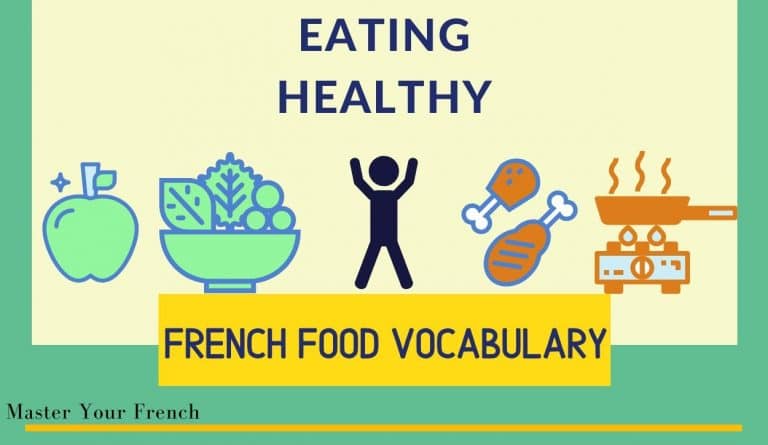
Today, more than ever, it is important to stay in shape. The most important thing is eating healthy. Preparing and sharing food is one of, perhaps the essential, pleasures of French culture. In this article, you’ll discover the French food vocabulary for eating healthy.
Let’s talk about healthy food in French
To start, I’m going to give you four tips that will help you to eat healthily. You’ll discover the French culture and habits around food.
Here is the list of French vocabulary that I’ll cover in this article:
- Fruits of the spring season
- Vegetables of the spring season
- Starchy Food
- The benefits of local food
- Protein and dairy products
- The French meals
Eating healthy Tips (Video)
Check out this video in French that explains everything in this post. Click to watch French food vocabulary and tips.
To follow more updates, subscribe to the YouTube channel and follow me on Instagram.
1. Consume fruits and vegetables
The first tip is to have a preference for the fruits and vegetables in your dishes and if possible, the fruits and vegetables that are in season.
In spring, among the fruits in season that are available:
- la pomme: apple
- la poire: pear
- le pamplemousse: grapefruit
- la fraise: strawberry
- la cerise: cherry
- la rhubarbe: rhubarb
- la tomate: tomato
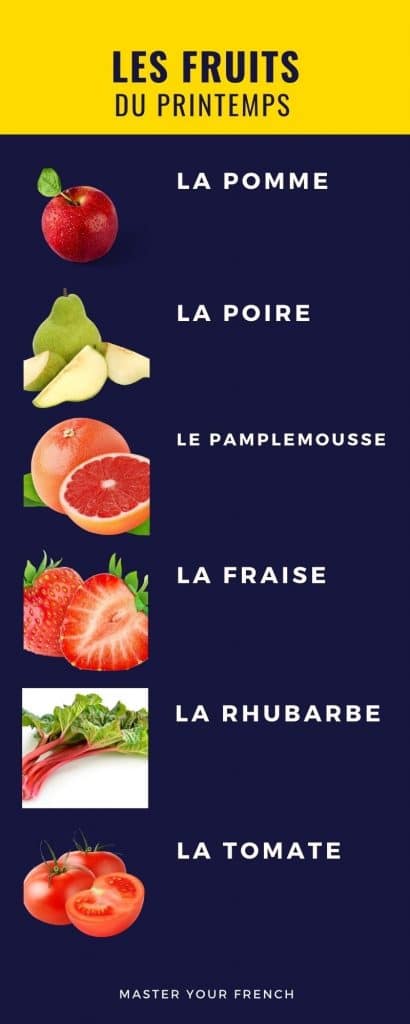
In spring, the vegetables in season are:
- le concombre: cucumber
- la carotte: carrot
- l’asperge: asparagus
- l’endive: endive
- les épinards: spinaches
- la betterave: beetroot
- la blette: chard
- la laitue: lettuce
- le petit pois: pea
- le navet: turnip
- le chou-fleur: cauliflower
- le radis: radish
- le poireau: leek
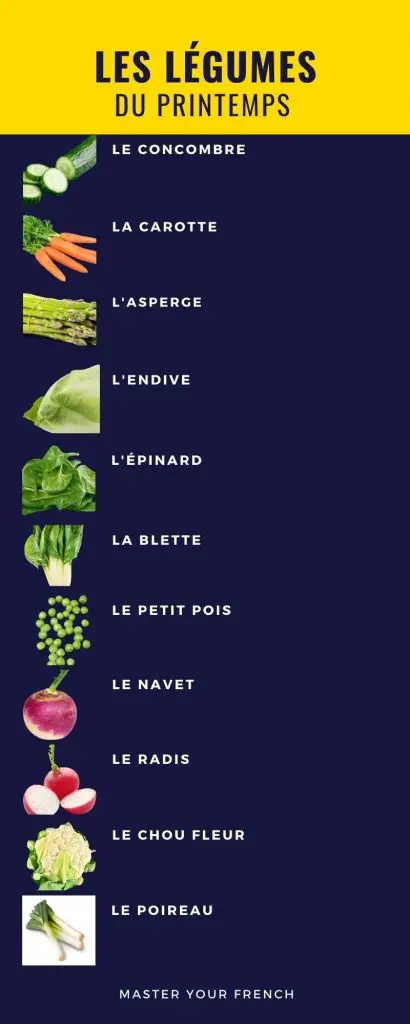
2. Eat in moderation
The second tip is to eat in moderation and in particular: starchy foods. Do not mainly eat pasta. You have to eat various starchy food.
I propose that you consume for example:
- le quinoa: quinoa
- la semoule: semolina
- l’avoine: oat
One benefit of starchy foods is that you can store them for a long time.
Leguminous vegetables are also a good choice. Here are a few ideas:
- des haricots rouges: kidney beans
- des haricots blancs: navy beans
- des lentilles corail: coral lentils
- des lentilles vertes: green lentils
- des fèves: beans
- des pois chiches: chickpeas
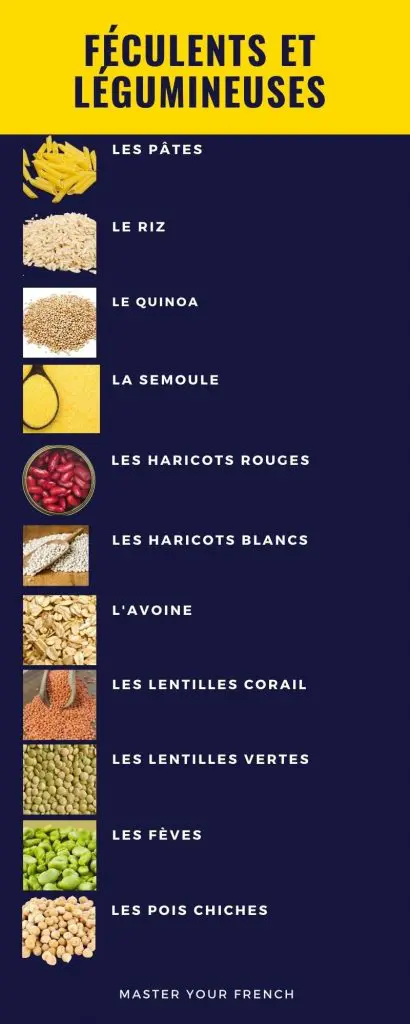
3. Cook more
The third tip is to cook as much as you can instead of consuming ready-made dishes such as canned food or frozen foods.
Avoid consuming a frozen pizza instead, if possible, cook a pizza yourself. Usually French take time to choose and buy les ingrédients (ingredients), and then they prepare les repas (meals). In other words, there’s space for food in the daily routine. You can learn more tips on the French Program “Nutrition Santé“. By the way, you could read a recipe in French. It’s a very good exercise to improve your French.
Local can be more important than organic
French tend to aim for quality over quantity. Almost every village and town in the country boasts a bustling market featuring local sausages, patties of farm-made chèvre (goat), strawberries, and tomatoes in the appropriate season.
Each little village has a weekly outdoor market, sometimes it’s only a few vendors, usually on Wednesday or during the weekend. Typical French markets are a mix between the farmers’ market and a traders’ market, with stalls offering local produce straight from the farm standing alongside fruit, vegetable, cheese, chicken, cereals, fish, meat, or bread.
Eating local foods has many advantages:
- Taste: local products are simply as tasty as possible.
The explanation is simple: local products are often harvested at maturity and shipped the same day. When they arrive in our basket and later on our plate they could not be tastier. - Health: When you buy products from local agriculture and organically grown, you can be sure that there will be no trace of pesticides, antibiotic residues, or OGM (GMOs).
- Quality: The local products were cultivated on rich and dense soils, they were harvested at maturity, and a very short period of time elapses between harvest and sale. When we buy local fruits and vegetables, they are not only fresh but also full of vitamins and essential nutrients: they are more nutritious and bring to our body all their benefits.
4. Diversify what you eat
We already talked about fruits and vegetables and starchy foods. You can also consume protein foods such as in:
- la viande rouge: red meat
- le poulet: chicken
- les oeufs: eggs
- le poisson: fish
You can also eat dairy products such as:
- le fromage frais: fresh cheese
- les yaourts nature: plain yogurts
- le lait: milk

You have to consume all these products in moderation. Healthy food in France comes from moderation. There are no forbidden foods, the only excess is looked down upon. The only thing that you can consume without moderation is water.
Did you know that the French don’t snack?
In her delightful tale, Mireille Guiliano unlocks the simple secrets of this French paradox: how to enjoy food and stay slim and healthy.
French tend to aim for quality over quantity and they don’t snack.
The meals in France
While the most important meal is le déjeuner (lunch), French people enjoy three main meals during the day.
Le petit déjeuner (7h-9h) – Breakfast
The French breakfast is usually a simple fare. It consists of sliced bread with jam and some coffee, tea or hot chocolate served in bowls. The first thing that you can find in a French breakfast is the bread. Most often, bread takes the form of the baguette. French people do not buy their baguette at the supermarket but at the bakery.
There are different kinds of bread:
- la baguette: normal baguette
- la tradition: tradition baguette
- le pain complet: wholemeal bread
- le pain de seigle: rye bread
- le pain céréale: cereal bread
- le pain de campagne: farmhouse bread
- la brioche: sweet bread
French breakfast is sweet:
- les biscottes: crispbreads
- un toast: toasted bread
- you can toast your bread with a grille-pain (toaster)
- you can make a tartine with confiture and/or beurre (butter) or miel (honey)
- un produit laitier (dairy product) like milk or yogurt
- you can also have a fruit
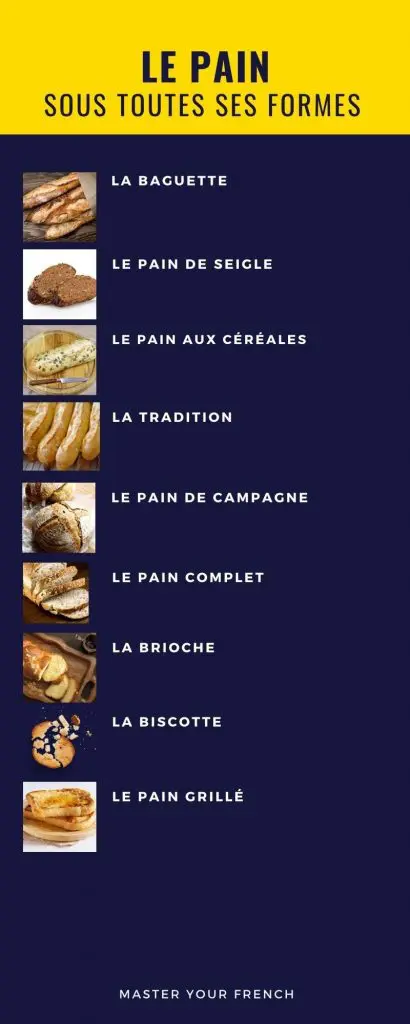
French usually drink:
- café: coffee
- thé: tea
- chicorée
- jus d’orange: orange juice
Kids usually eat:
- chocolat au lait: hot chocolate
- céréales: cereals
- une brioche: sweet bread
French don’t eat croissant and pain au chocolat in the morning. They eat what they have in the kitchen. They usually buy croissant and pain au chocolat if they have guests at home or they want to bring something sweet to eat for their colleagues at work.
Eating fresh croissant and pain au chocolat means going to the bakery in the morning and coming back to the house to eat them. Because there is no place in the bakery to eat your breakfast and French don’t eat while walking.
Déjeuner (12h-14h) – Lunch
French typically spend at least one or two hours over lunch. The French secret is to sit down with friends or family for a meal and to eat three times a day at regular intervals. French don’t eat in front of the television, and they eat slowly, enjoying both the food and the company. Adults don’t eat between meals.
Food has a defined time and place, three meals a day:
- l’entrée: starter
- le plat principal: main course
- le fromage (optional): cheese
- le dessert: dessert
Le goûter (16h-17h) – School snack
Kids get an afternoon goûter each day after school, and the adults might join them sometimes. The goûter is light and sweet: un fruit, une barre de céréale (cereal bar), une compote (compote) ou une part de cake (piece of cake).
Le dîner (19h-21h) – Diner
The French Diner is late but it’s light. They usually have a salade during the summer and soup during the winter. After that, French people usually have a dairy product such as cheese or yogurt.
Keep learning
If you’d like to learn how to overcome pronunciation difficulties or listening challenges in French you can join these online French courses.
Accessing a program that is made to help you learn French will give you the right push to take a further step to boost your French learning better and faster.
Beyond these tips to learn French, you can watch our YouTube videos in French.



Very detailed article. I’ll keep this for further use. Thanks.
Hello Diana! Thank you for the comment. A très bientôt!